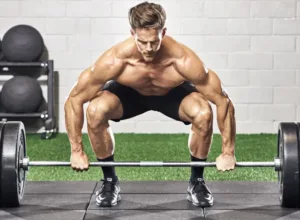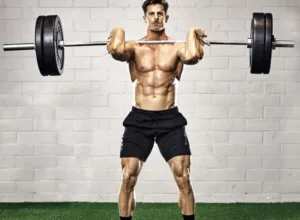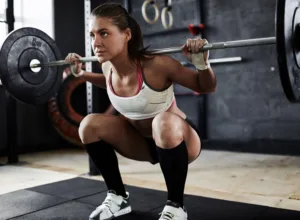Weightlifting isn’t just for bodybuilders anymore. It’s a fantastic way to improve your overall health and fitness, regardless of your age, experience level, or goals. Whether you want to build muscle, lose fat, improve bone density, or simply get stronger, weightlifting can help you achieve those results.
Even with gyms closing, New Year’s Eve is coming and people want to get in shape. But starting the steps to take on a new exercise program can be confusing. It feels like there are one hundred ways to get fit, and just as many checklists, strength goals, and pieces of data to sift through before making a decision. Synthesizing everything can feel paralyzing. Which exercises should you do? And how? If you’re thinking about lifting, how do you know it’s for you?
The choice, really, is easy, and there’s no downside. Being active in any way is a good thing. Some exercises might be better than others at achieving certain goals, but all are good. Choosing between lifting, or yoga, or swimming, or running shouldn’t feel overwhelming. It’s like picking dessert at a restaurant! There are no downsides, the decision isn’t permanent, and going one way doesn’t preclude a change of direction down the line. In fact, related athletic experience often helps.
Running can be a mystery, but people choose to lift for different reasons. Some people like the feeling of lifting weights — the pump. Some people simply like hanging out at the gym. Not everyone enters a gym with goals, but many who start lifting for fun adopt them. For example, after a few months of curls, you might want to hit a milestone squat. To get there, you don’t have to start from scratch, but you do need a plan and expectations.
This beginner’s guide will equip you with the knowledge and confidence to step into the weight room feeling prepared for your first workout.
Getting Started:
- Clear Your Doctor: Before starting any new exercise program, especially if you have any underlying health conditions, consult your doctor to get clearance.
- Set SMART Goals: Having specific, measurable, achievable, relevant, and time-bound goals will keep you motivated and focused throughout your weight lifting journey.
- Find the Right Gym: Look for a gym with a clean and friendly environment, and equipment that caters to beginners. Consider a gym with trainers who can guide you through proper form and technique.
- Invest in Proper Gear: Supportive athletic shoes and comfortable workout clothes are essential. Consider investing in a weightlifting belt or wrist wraps as you progress.
Learning the Basics:
- Focus on Form: Proper form is crucial to prevent injuries and maximize your results. It’s better to start with lighter weights and perfect your form before increasing the weight.
- Compound Lifts: These exercises work multiple muscle groups at once, making them efficient and effective for building strength. Examples include squats, deadlifts, bench presses, rows, and overhead presses.
- Isolation Exercises: After mastering compound lifts, incorporate isolation exercises to target specific muscle groups. Examples include bicep curls, tricep extensions, calf raises, and lateral raises.
Sample Beginner Workout Routine:
This is a basic full-body workout routine you can perform 2-3 times per week, with at least one rest day in between. It focuses on compound lifts and uses dumbbells for easier form awareness.
- Warm-up (5-10 minutes): Light cardio like jumping jacks, followed by dynamic stretches like arm circles and leg swings.
- Squats (3 sets of 10-12 repetitions): Focus on keeping your core engaged, back straight, and knees tracking over your toes.
- Dumbbell Bench Press (3 sets of 10-12 repetitions): Lie on a flat bench with dumbbells in each hand, pressing them straight up towards the ceiling.
- Dumbbell Rows (3 sets of 10-12 repetitions): Hinge at the hips with your back straight, core engaged, and dumbbells rows towards your chest.
- Overhead Press (3 sets of 10-12 repetitions): Stand with dumbbells held shoulder-height, and press them straight overhead.
- Dumbbell Romanian Deadlifts (3 sets of 10-12 repetitions): Hinge at the hips with dumbbells in each hand, keeping your back straight and core engaged, lowering the weights towards the ground.
- Cool-down (5-10 minutes): Static stretches to improve flexibility, focusing on major muscle groups.
What to Expect:
- Muscle Soreness: Especially during the first few weeks, expect some muscle soreness after your workouts. This is a normal adaptation process called Delayed Onset Muscle Soreness (DOMS). Proper stretching and rest will help alleviate soreness.
- Gradual Progress: Building strength and muscle takes time and consistency. Don’t get discouraged if you don’t see results overnight. Be patient, stay focused, and celebrate small victories.
- Increased Energy Levels: As your body adapts to weight training, you may experience increased energy levels throughout the day due to improved muscle function and metabolism.
- Improved Body Composition: Weight training helps build muscle and burn fat, leading to a more toned and defined physique.

 Step one: Bring in a Program.
Step one: Bring in a Program.
Most lifters reach these goals through programs, which are planned series of regular workouts that go on for months. There might be an infinite number of programs, and picking one gives pause. Some programs build up to a max weight attempt; some test strength, some build it, some test skill. But as far as new lifters are concerned, the similarities between programs outweigh their differences.
Lifters’ goals and what a program can actually deliver meet in the middle. Lifters generally want to get strong or big. Some may have more specific goals: like replicating an actor or actress’s look in a movie, or getting in shape for pick-up sports, or staving off back pain. Most programs can achieve these goals, but none are specifically designed for them.
Programs deliver on goals as a side-effect. Powerlifting programs, by training the sport’s three main lifts, are an excellent way to get strong and a good way to get big — but are designed for expertise in those lifts. Bodybuilding programs, where lifting is a means to the end of molding a body into the shape most ideal for winning a posing competition, will, as a side effect, strengthen a lifter as well.
Quick language note. This column has used the terms weightlifting, powerlifting, bodybuilding, and strength training interchangeably as short-hand for working out with weights, but they are different things. Powerlifting is a competitive sport where the total weight for three lifts is counted; its programs maximize their expression. Bodybuilding is a sport that emphasizes physique — parts of it over others — and its workouts reflect that. Weightlifting is what they do in the Olympics — there’s a difference between weight lifting (two words) and weightlifting.
A good, proven program places a lifter on a continuum and builds strength and size, even if it prioritizes one over the other. This should be freeing for lifters. If you Google around and ask questions, you’ll find a program you need. The choice is good up to a point. But it’s like getting a tattoo. You don’t get the one in your head, but the one at the shop. The key is living up to a program that’s good enough for everybody else in the past. Only when lifters temper their expectations for a perfectly-tailored workout plan can they get to work.
But while strength training comprises hundreds of hyper-specific goals, its foundations — for starting a program, sticking with it, and progressing — are simple. And no matter the program, or goal, or lifter’s age, ability, or health level, there’s only one way to succeed. Lifters need to eat right and get lots of sleep and do as much as they can, but no more than that.
Step two: What to expect and what to ignore
But what about the program? Hang on — there’s still a bit of theory left. Because new lifters are more adaptable, they can put on muscle easily through almost any combination of exercises. Younger lifters will see the most adaptation, but new lifters more advanced in age should also progress, from middle-aged folks to seniors. Older lifters are more likely to have been injured and get injured, and so desk jockeys and senior citizens should get movement assessments before they get under the bar. But progress is real, no matter the age, so long as there’s adequate sleep, and nutrition, and effort.
 The anecdotal evidence that every exercise, good or bad, seems to work for beginner lifters is backed up by science. A study published in the Journal of Applied Physiology suggests expenditure is the most important factor in a workout’s success, more than weight moved or a number of reps. Professor Stuart Philips, the study’s senior author and a lifter himself, says “consistent practice combined with good nutrition and practicing good form and working to fatigue — no matter what the load — is what makes up the majority of results.” It’s one reason why people who do the wrong lifts the right way still seem to get big.
The anecdotal evidence that every exercise, good or bad, seems to work for beginner lifters is backed up by science. A study published in the Journal of Applied Physiology suggests expenditure is the most important factor in a workout’s success, more than weight moved or a number of reps. Professor Stuart Philips, the study’s senior author and a lifter himself, says “consistent practice combined with good nutrition and practicing good form and working to fatigue — no matter what the load — is what makes up the majority of results.” It’s one reason why people who do the wrong lifts the right way still seem to get big.
No matter the program — which I’ll get to soon — workouts should be performed to the max. Max, in this case, does not need to mean a heavyweight, but the lifter’s subjective maximum, or close to it. The weight should feel, if not heavy all the time like it’s there — and at the end of a workout, a lifter should feel spent.
A heavyweight, of course, is different from a harmful one. It’s important to distinguish between pain. Glutes and thighs screaming after a squat session is fine. Sharp pain in your back isn’t. Trainers I’ve spoken to say that sort of “bad pain” should never be felt higher than a two on the 1 to 10 scale. If it is, you should stop.
Step three: How to choose a program
For any program, the form is important: movements, no matter the weight, should be fluid, smooth, and fast.
There are, however, exceptions, like testing a one-rep max, or high RPE lifts at the end of a program. Lifters should tape their workouts, and have a coach or peer review their form; supervised lifting seems ideal at the start. It’s no good if a squat is balky or a deadlift has no range of motion. That might mean the weight is too heavy, or that a lifter is too stiff or weak, to earnestly push themselves with barbell work. These types of situations should be run by a coach, and often mean more prep is needed. This means bringing in a powerlifting ramp-up program, or mobility work, or a dumbbell program. While these steps back are disheartening, they’re necessary. Barbell work is a means to an end but is also a skill. It requires proprioception — a sort of spatial awareness that sometimes needs to be developed.
Very roughly speaking, if lifters prioritize diet and sleep, they will get stronger and bigger working on any program. (Macros counting is the path to “solving” the food problem, and adequate nutrition can stave off soreness. Lifters should aim for at least seven hours of sleep a night.) Which takes the pressure off finding a perfect program.
Luckily, there’s a wealth of good ones to choose from. So-called beginner powerlifting programs — like Greyskull — are great and get results. More specialized programs, like GZCL are designed for a variety of lifters and work well for beginners. Strong Curves is designed for women (though there’s no need for women to pick a gendered program). There are dumbbell programs designed for people without access to barbells, are ideal for lifters in quarantine, or those who don’t want to pay for a gym. There are bodyweight programs, bodybuilding ones, programs for Olympic weightlifting, and ones for explosivity. It’s an endless list, and a welcoming one: any, if taken seriously, will deliver results.
Now that the theory is down, here’s an example of how a powerlifting timeline might work. A lifter in December wants to get strong, and picks a program, settling on Jim Wendler’s 5-3-1, which is somewhat out of vogue, but has worked in the past, and will work in the future, and has a variety of options beyond the beginner option.
After reading Wendler’s book a few times, and understanding Wendler’s schedule and goals, a lifter will find their one-rep max — Wendler says when in doubt, go too light — get a kitchen scale, and begin buying decent groceries. Come January, the program starts, and a lifter should follow the workouts, and do the conditioning, aiming for fluid, strong lifts, and a good range of movement. (If that’s too hard, lower the one-rep max, or start a GPP program, or a different beginner program that builds up proprioception, or talk to a coach.) Eat above maintenance, and sleep. It will work.
Any other program — powerlifting or bodybuilding; barbell or dumbbells, trendy or not — will shake out the same. The difference in results between the handfuls of fine, vetted programs is negligible compared to the slide that can happen if a lifter eats poorly or shirks an exercise. Choose almost any protocol off here, and if you work hard, you’ll see results. It’s as much about the effort, and the lifter, as the program.
What’s nice is that since lifters lift for years, from youth into old age, there’s no rush. Sometimes the new year isn’t the right time to start. If, when the calendar turns, you can only work out once a week, and do arms — do that. When it’s easy, do more. There’s no perfect program, or path, just habit and effort, and adjustment. If you want to start lifting in the new year, be prepared to lift beyond it. That long timeline is freeing. It’s through a routine that all other things come.
 Additional Tips:
Additional Tips:
- Stay Hydrated: Drink plenty of water before, during, and after your workouts to stay hydrated and support muscle recovery.
- Prioritize Sleep: Aim for 7-8 hours of sleep per night for optimal muscle recovery and hormonal balance.
- Eat a Healthy Diet: Fuel your body with nutritious foods rich in protein, complex carbohydrates, and healthy fats to support muscle growth and repair.
- Listen to Your Body: Take rest days when needed, and don’t push yourself through pain.
- Find a Workout Buddy: Having a workout partner can increase motivation, accountability, and make the gym experience more enjoyable.
Wrapping Up
Weight lifting is a journey, not a destination. Embrace the process, celebrate your progress, and enjoy the empowering feeling of getting stronger and healthier with each workout!
More About Bodybuilding Tips for Beginners and Beyond Guide Contents

For More News And Daily Updates, Follow IFBNewsfeed.Org™🇺🇸 on Facebook, Twitter, and Instagram. Comment, Like, And Share With Everyone Who May Need To Be Updated With The Most Recent Fitness/Bodybuilding/Powerlifting And CrossFit News.


 The anecdotal evidence that every exercise, good or bad, seems to work for beginner lifters is backed up by science. A study published in the Journal of Applied Physiology suggests expenditure is the most important factor in a workout’s success, more than weight moved or a number of reps. Professor Stuart Philips, the study’s senior author and a lifter himself, says “consistent practice combined with good nutrition and practicing good form and working to fatigue — no matter what the load — is what makes up the majority of results.” It’s one reason why people who do the wrong lifts the right way still seem to get big.
The anecdotal evidence that every exercise, good or bad, seems to work for beginner lifters is backed up by science. A study published in the Journal of Applied Physiology suggests expenditure is the most important factor in a workout’s success, more than weight moved or a number of reps. Professor Stuart Philips, the study’s senior author and a lifter himself, says “consistent practice combined with good nutrition and practicing good form and working to fatigue — no matter what the load — is what makes up the majority of results.” It’s one reason why people who do the wrong lifts the right way still seem to get big. Additional Tips:
Additional Tips:









